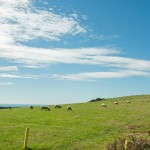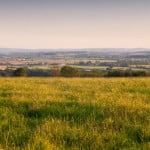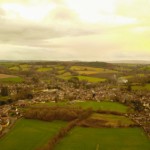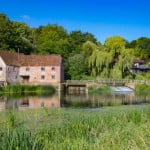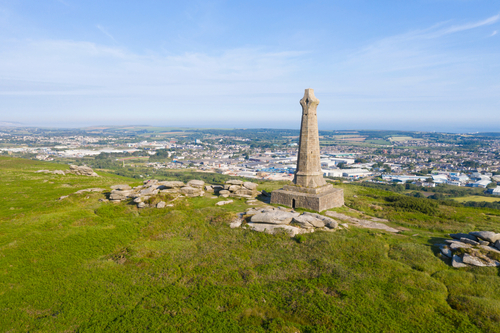
Redruth is a town and civil parish in the west of Cornwall, southwest England. It’s located 12 miles (19 km) east of St Ives and 9 miles (14 km) west of Truro. Redruth is perhaps best known for once being at the centre of Cornwall’s thriving tin and copper industries of the 18th and 19th centuries The Camborne-Redruth urban and surrounding area forms the largest conurbation in Cornwall, with a population of more than 55,000. The population of Redruth itself was recorded as 14,018 at the last UK national census in 2011.
A Fleeting Redruth History
Redruth was first settled sometime during the 12th century when a few settlers decided to build their cottages at a ford in the river, close to an existing church. However, Redruth remained nothing more than a small village up until 1334 when it was duly granted a royal charter for a twice-weekly market and an annual fair.
Around the late 14th-century small scale mining began in the Redruth area when locals began to exploit the shallow deposits of tin and copper ores that had been exposed by the effects of river action. The resultant red running waters from the practice of mining were responsible for its name of the Red River.
The name of the river and its location at a ford led to the town being given the Cornish name of ‘Resrudh’. This translates as ‘Red-ford’, although perhaps a little ambiguously, it’s the term ‘res’ that means ford, while the ‘rudh’ part means red. In time, the name ‘Resrudh’, was anglicised to Redruth.
During the 16th and 17th centuries, the inhabitants of Redruth saw little change in their daily lives or the town. However, in 1660, Charles II did grant a new charter, decreeing that the town could hold markets on Tuesdays and Fridays. During the early 1720s, famed author, journalist and traveller, Daniel Defoe, passed through Redruth, describing it in his book, “A tour thro’ the whole island of Great Britain”, as being a place “worthy of no consideration”.
However, within a decade Redruth would undergo a dramatic transformation. By the 1730s, the newly invented steam engine was being utilised for the purpose of de-watering mines, meaning they could now be dug much deeper. Redruth with its extensive deep underground deposits of both tin and copper quickly became the centre of Cornwall’s prosperous mining industry.
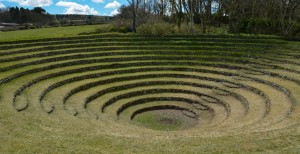
Image: Keith 316/Shutterstock.com
In the mid-18th century, Redruth was described by one writer as consisting of “one main street about half a mile long”, but from there it was to grow rapidly. It was also in the mid-18th century that John Wesley, founder of Methodist Church, began visiting Cornwall. By 1750, he had established some 30 Methodist societies of the mining communities of West Cornwall.
In 1763, Wesley came to Redruth for the first time on what was his fourteenth visit to Cornwall to preach at the natural amphitheatre of Gwennap Pit. By 1789, he’d made a further seventeen visits to the site, remarking that the gatherings at the Pit were ‘the most magnificent spectacle this side of heaven. By 1798, the Methodist membership figures for the Redruth community were the fourth largest in the whole of Britain.
In 1791, Redruth was described as having by far the biggest market in Cornwall. By this time, famed Scottish engineer and inventor, William Murdoch was resident in the town’s Cross Street, working for the prestigious ‘Watt and Boulton’ company. In 1792, he took the initiative to rig up piped coal gas to power the lighting of his home (now Murdoch House). It was a world first and was to lay the foundations for today’s gas industry.
By 1801, Redruth had a population of almost 5,000 people, quite a large town by the standards of the day. Through the early part of the 19th century, Redruth continued to benefit from the area’s mining boom. By 1827, the town’s streets were lit by gaslight. In 1828, the Town Clock was erected, and in 1838, a railway station on the new Redruth to Hayle line opened. In 1850, a new Town Hall was built. By 1852, the railway had been extended west to Penzance and east to Truro, which involved a new rail viaduct being built in the town and the present-day railway station.
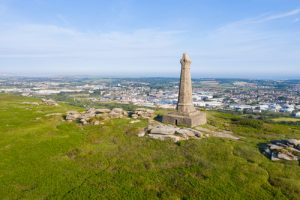
Image: Tim Woolcock Photography
Yet, not everyone in Redruth benefitted equally from the mining bonanza, least of all the miners and their families themselves, who in general only managed to exist just above the breadline. Between the late 18th and mid-19th century, Cornwall, and in particular, Redruth became infamous for its food riots. Large groups would gather at markets and demand that foodstuff be sold for a reasonable price rather than the asking price, often backing up the request with threats of violence.
The last ‘food riot’ in the Redruth area took place in 1847 and attracted a reported angry crowd of up to 5,000. However, after 1847, rising wages and a better police force helped to eradicate the practice of food riots.
Off to Australia
In 1859, large deposits of copper were found in South Australia, causing a dramatic fall in the price of Cornish copper. Many hundreds of Cornish miners moved to the other side of the world for work, taking the customs and traditions of Cornish life with them. In fact, so many Cornish folks settled in South Australia’s mining area that it became known as ‘Little Cornwall’. By 1866, all of Cornwall’s copper mines had closed, putting those miners that had remained in Cornwall out of work. The economic depression initiated by the decline of mining was now greatly affecting the wider Cornish community. Miners did at least have the option of emigration.
However, things were about to get worse for Cornwall’s mining industry. In 1872, large deposits of tin were discovered in the Australian states of Queensland, New South Wales and Tasmania. Further competition from Malaya and Bolivia proved to be the final nail in the coffin for Cornwall’s tin industry. Mirroring the fate of copper just a few years before, the price of Cornish tin now collapsed. In the first six months of 1875 alone, more than 10,000 miners left Cornwall to find work overseas, mostly in the USA and Australia, but later, to South Africa as well.
Nonetheless, Redruth continued to develop, in 1880, the Mining Exchange was built to trade local mining stocks. The School of Mines and Art School opened circa 1882, St. Andrew’s Church in 1883 and the Free Library, in 1895. By the turn of the century, Victoria Park had been laid out to commemorate the Queen’s Diamond Jubilee.
20th Century Redruth
In 1902, the Camborne and Redruth Tramways company was set up and began operating Cornwall’s only ever tram service. The electric trams provided a regular freight and passengers service between the two towns, enjoying early success. However, in 1926, the Cornish Motor Transport Company began operating a bus service between Redruth and Camborne which proved more efficient, reducing the patronage of the tram service. The tram company began to lose money and ceased its passenger operation in 1927. The freight service managed to survive until 1934 before it to was forced into closure.
In August 1914, Fair Meadow at Redruth was chosen as a muster point for horses that were being requisitioned by the army for the war effort. In 1939, at the start of WW2, schoolchildren were evacuated to Redruth, where it was deemed to be safe. However, it did not escape German bombs, entirely. The worst bombing incident occurred on 20th March 1941 when a stray Luftwaffe plane dropped 11 bombs on the town’s railway. There were six fatalities, nine people were seriously injured, and a further seven slightly injured. Two houses were also destroyed, along with a great deal of other damage to property.
The Modern Era
Today, like much of the rest of Cornwall, Redruth suffers from relatively high unemployment, with few well-paying job opportunities. The majority of people in Redruth are employed in the service sector, with tourism becoming increasingly important to the town. However, one bright spot on the horizon (2020) is that advancement in mining techniques has led to the possibility that South Crofty, may be reopened for the mining of copper and lithium. South Crofty Pit closed in 1998 and was the last working tin mine throughout the whole of Europe. Obviously, the move to reopen has great potential to create some local well-paid jobs and attract much needed inward investment to the area.
Getting There!
Redruth is a fairly remote location but it has relatively good rail, road, and air connectivity with the rest of the country.
By Road
Despite its relatively remote location, getting to Redruth by road is relatively easy. Just follow the M5 motorway towards Exeter until you reach the A30. Stay on the A30 all the way to the The Avers Roundabout on the Camborne-Pool-Redruth Bypass. From there turn on to the A3047, from which Redruth is a short drive.
By Bus
National Express runs 4 buses daily from London Victoria to Redruth with a journey time of around 8.5 hours. From the North and the Midlands, you may need to change buses at Bristol.
By Train
The direct train services from London Paddington, South Wales and Scotland to Penzance, stop at Redruth. There’s also a sleeper service from London Paddington.
By Air
The nearest airport to Redruth is Newquay, to which regular services from London Gatwick and Manchester fly. From Newquay airport, expect it to take about 35 minutes by taxi or car for the 25-mile drive to Redruth. Alternatively, take the bus from the airport to Truro, and from there, the train to Redruth.
Sport
Redruth RFC
Redruth Rugby Football Club is one of Cornwall’s top teams, currently play in National League 2 South, which is the 4th tier of rugby union in England. They play their home games at the Recreation Ground which has a capacity of approximately 3,500.
Redruth CC
Redruth Cricket Club play in the Cornwall Cricket League ECB Premier League.
Notable Redruth People
Some notable people who were born or have lived in Redruth, include:
- Mick Fleetwood – born in Redruth in 1947, is the drummer and co-founder of the long-surviving rock group; Fleetwood Mac.
- Rory McGrath – born in Redruth in 1956, is a noted British TV personality, writer and comedian.
- Kristin Scott Thomas – born in Redruth in 1960, is a world-renown award-winning actress.
- William Murdoch (1754-1839) – the Scottish engineer and inventor, lived in Redruth’s Cross Street between 1782 and 1798.
Did you know?
- Redruth was a terminus station for Cornwall’s one and only tram service that operated from 1902 to 1934.
- Redruth is situated within the UNESCO World Heritage Site that recognises Cornwall’s unique mining legacy.
- In 1779 Murdoch House in Redruth became the first dwelling anywhere in the world to be lit by gaslight.
- John Wesley, the founder of the Methodist Church, was a regular visitor to Redruth between 1763 and 1789.
- The Great Estate Festival is one of the biggest annual events in the Redruth calendar. Taking place in late May/early June at the grounds of Scorrier House, about 2 miles from Redruth, the 3-day event is a fusion of music, art, theatre and comedy, accompanied by plenty of food and drink.
- Redruth is twinned with Plumergat et Meriadec, Brittany, France; Mineral Point, Wisconsin, USA and Real del Monte, Hidalgo, Mexico.
Things to see and do!
A few recommendations for things to see and do around Redruth are;
- King Edward Mine Museum – is a mine that dating back to the 19th century where most of the equipment has been restored to working order. The Grade II listed buildings form part of the World Heritage Area of Cornwall. The Museum is only open during the summer months.
- Tehidy Country Park – once owned by the powerful Basset family is now in the hands of Cornwall County Council. It has some 9 miles (15km) of paths, 250 acres of woodlands and lakes, and lots of wildlife. There’s also a café and a picnic area. There are five main access points with car parks at South Drive and North Cliff.
- Gwennap Pit – formed by the failing ground of old mine workings, the tiered amphitheatre-like structure is a memorial to the Methodist movement of the 18th century. Still used as a place of worship, it’s only a mile outside of Redruth.
- Carn Brea – is a wide-open area of outstanding countryside that overlooks both Camborne and Redruth that reaches 738 ft above sea level. Close to the peak, there’s a 90 ft granite obelisk built in 1836 and dedicated to local mining entrepreneur, Sir Francis Basset (1757 – 1835). There’s also an 18th-century folly, Carn Brea Castle, built by the Bassett family on the site of an old chapel, which is now a restaurant.
- Feadon Farm Wildlife Centre – is an animal rescue centre, farm and falconry, which also offers rock pooling on Portreath Beach. You’ll also be able to enjoy a live, interactive experience with the animals at the Farm, which include the likes of foxes, hedgehogs, goats, bats, squirrels, donkeys, reindeer, etc. All activities must be pre-booked.
- Heartlands – is an all-year-round and all-weather entertainment centre for all. The 7.5-hectare site has, amongst other attractions, state-of-the-art exhibitions, climb-on sculptures, diverse gardens, a kid’s giant adventure playscape area, art and craft studios and a unique café housed in a carpenter’s old workshop.
- East Pool Mine – is a mining museum with original above-ground buildings that have been restored and utilised to house exhibition material. As well as short films and photographs, there are also models and hands-on activities to explain how the mine operated. There’s also free parking, tea and coffee available, and a small shop.
Where to stay?
If you’re looking for somewhere to stay in Redruth then accommodation is fairly limited, especially if you are looking for a top-end room. Camborne and Portreath are only 3 or so miles away which obviously gives more options. Hayle and Truro about 10 miles away, offer yet more choice. Prices are pretty similar throughout the area. A broad indication of prices for 2 adults sharing for the most common types of accommodation in the general area are:
B & B/Guesthouses: £60 – £90
Standard Hotels/Inns £90 – £130
3/4/5 Star Hotels £130 – £250
Moving to Redruth?
Thinking of moving to Redruth? The average property price in the Redruth area for July 2020 stood at approximately £196,900. This represents a fall of about 12 % on the average price paid in the last 12 months. In terms of property types, flats were selling for an average of £117,800 and terraced houses for £158,400.
So there you have it our Five Minute Overview of Redruth. Before you go why not try some of our other quizzes or have a look at some of our other location guides. better still why not join our growing community it’s free and could be very rewarding going forward.

